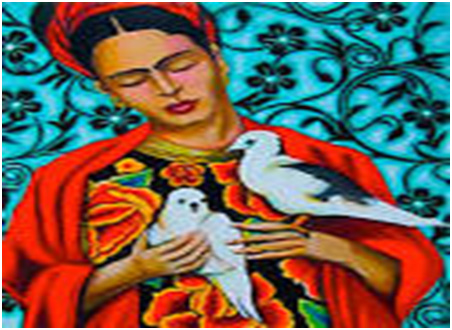Frida Kahlo
Artist Frida Kahlo was born on July 6, 1907, in Mexico City. Considered one of Mexico’s greatest artists, Frida Kahlo began painting after she was severely injured in a bus accident.
Kahlo grew up in the family’s home where she was born -- later referred to as the Blue House. Her father was a German photographer who had immigrated to Mexico where he met and married her mother. She had two older sisters and one younger sister.
In 1922, Kahlo enrolled at the renowned National Preparatory School. She was one of the few female students to attend the school, and she became known for her jovial spirit and her love for traditional and colorful clothes and jewelry. That same year, famed Mexican muralist Diego Rivera went to work on a project at the school. Kahlo often watched as Rivera created a mural called The Creation.

While at school, Kahlo hung out with a group of politically and intellectually like-minded students. She became romantically involved with one of them, Alejandro Gomez Arias. On September 17, 1925, Kahlo and Gomez Arias were traveling together on a bus when the vehicle collided with a streetcar.
After being hospitalized in Mexico City for several weeks, Kahlo returned home to recuperate further. She began painting during her recovery and finished her first self-portrait the following year. During this period of her life, Arias left her and she battled with bouts of depression. Meanwhile, becoming more politically active, Kahlo joined the Young Communist League and the Mexican Communist Party. Kahlo reconnected with Rivera, her friend from school, in 1928.
He encouraged her artwork, and the two began a relationship. The couple married the next year. During their early years together, Kahlo often followed Rivera to wherever the commissions that Rivera received were. In 1930, they lived in San Francisco, California, where Kahlo showed her painting Frieda and Diego Rivera. They then went to New York City for Rivera’s show at the Museum of Modern Art.
In 1932, Kahlo began to incorporate more graphic and surrealistic elements into her work. This can be seen in her paintings like Henry Ford Hospital (1932).
New York City in 1933 was surrounded by controversy; the couple soon returned to Mexico and went to live in San Angel, Mexico. Never a traditional union, Kahlo and Rivera kept separate for most of their time as a couple. Consequently, she was often saddened by his many infidelities. In response to this familial betrayal, Kahlo cut off most of her trademark long dark hair. Desperately wanting to have a child, she again experienced heartbreak when she miscarried in 1934.
She and Rivera went through periods of separation, but they joined together to help exiled Soviet communist Leon Trotsky and his wife Natalia in 1937.
In 1939, Kahlo went to live in Paris for a time. There she exhibited some of her paintings and developed friendships such artists as Marcel Duchamp and Pablo Picasso. She divorced Rivera later that year. During this time, she painted one of her most famous works, The Two Fridas (1939).
Oddly, Kahlo and Rivera did not stay divorced for long. They remarried in 1940, and yet the couple continued to lead largely separate lives. Both later became involved with other people over the years.
Kahlo received a commission from the Mexican government for five portraits of important Mexican women in 1941, but she was unable to finish the project. She lost her beloved father that year and continued to suffer from chronic health problems due to her accident. Despite her personal challenges, her work continued to grow in popularity and was included in numerous shows around this time.

In 1944, Kahlo painted The Broken Column. About a week after her 47th birthday, Kahlo died on July 13 at her beloved Blue House. Since her death, Kahlo’s fame as an artist has only grown. Her beloved Blue House was opened as a museum in 1958. The feminist movement of the 1970s led to renewed interest in her life and work, as Kahlo was viewed by many as an icon of female creativity.
By Milica Matic

